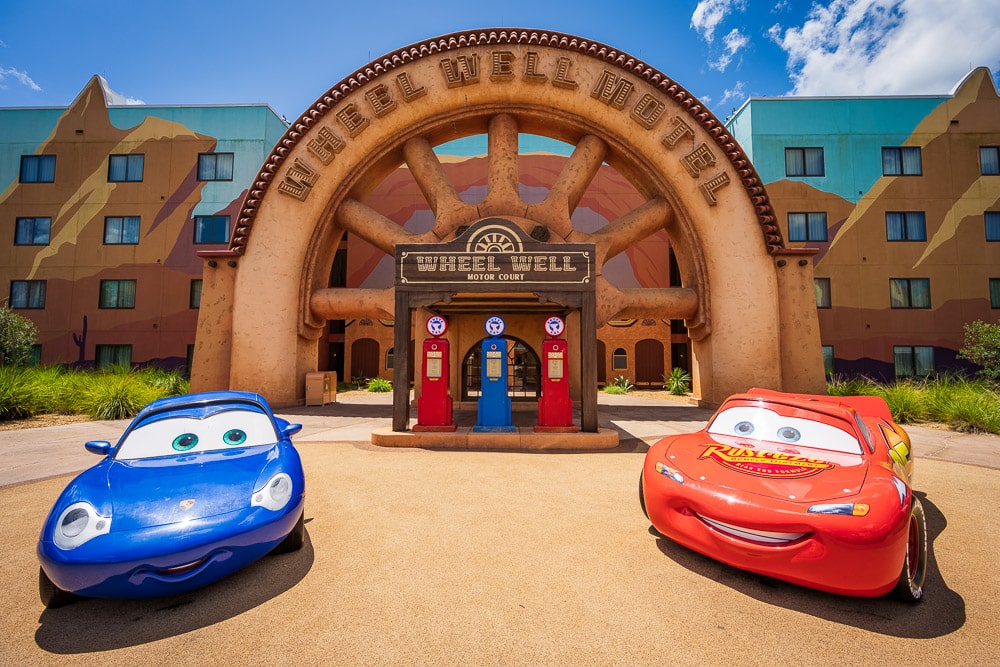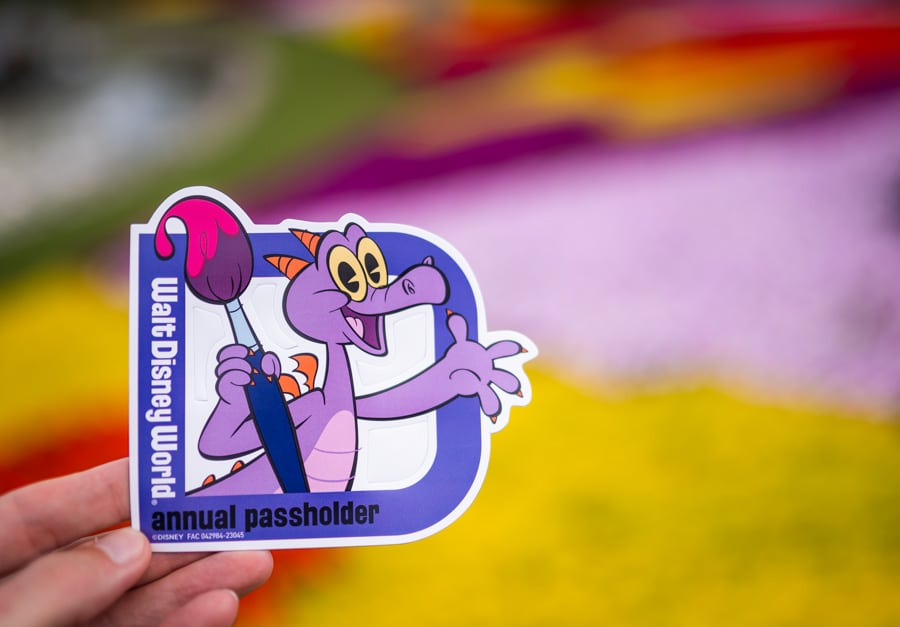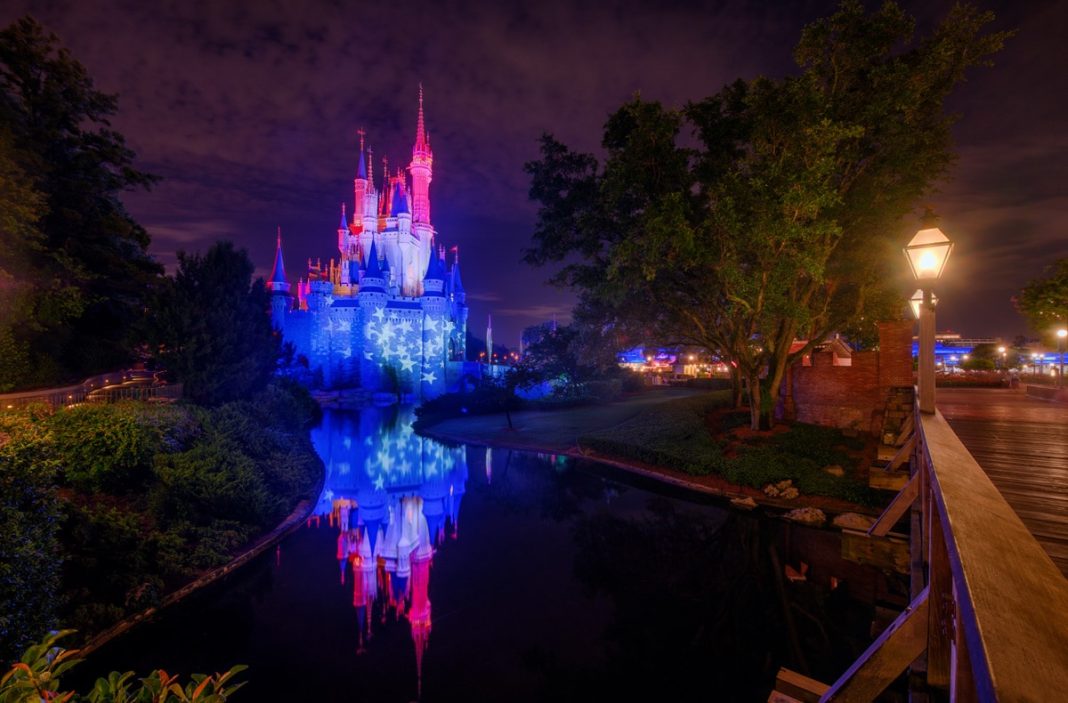
Wait times at Walt Disney World for Independence Day 2024 were once again low, following up last year when reports of the parks being “dead” or “ghost towns” made national news and prompted a response from CEO Bob Iger. This discusses the reasons for lower crowds during what used to be a popular holiday.
At least in part, this won’t come as a surprise to regular readers of this blog. Last month, we published Summer (Still) Is NOT High Crowds Season at Walt Disney World. The title pretty much says it all, so I’m not going to rehash all of that. The bottom line is that summer crowds have been unpredictable and inconsistent the last several years.
Summer hasn’t been peak season for a while–since 2016. There were a couple of years that were anomalies during the pent-up demand period, which is probably a big reason why some fans are being caught off-guard by the summer slowdown at Walt Disney World in 2024. Because it hasn’t been the case that summer has consistently been slow during the last 7 years.
You also might recall that Independence Day 2023 was downright dead at Walt Disney World. It was such a hot topic that it drew an explanation from CEO Bob Iger, who attributed the slowness to an exhaustion of pent-up demand in Florida as a whole and unseasonably bad weather. He wasn’t wrong…but he also wasn’t completely correct.
Aside from Independence Day, summer crowd levels were lower across the board last year. Certainly not on par with the off-season that followed, but not what you’d expect if you last experienced summer at Walt Disney World before 2016. It was downright delightful! Well…so long as you could endure the wicked weather. Minor asterisk.
The same thing has been true once again this summer, including Independence Day 2024. Per Thrill-Data, Walt Disney World as a whole had a crowd level of 1/10 with an average wait time of 26 minutes on July 4, 2024. For reference, that’s down as compared to the last two weeks of June, which had average wait times of 35 minutes (second to last week) and 31 minutes (last week).
However, it’s up as compared to last Independence Day, when the average wait time was only 22 minutes–that was on par with some of the slowest days in the August and September off-season!


Not all parks were equally uncrowded on July 4, 2024. Magic Kingdom outperformed slightly; EPCOT did so massively, with an 8/10 crowd level. These two parks being busiest is particularly unsurprising since they’re the only two with special Fourth of July fireworks shows and there’s currently a ticket deal that prevents Park Hopping.
It’s also worth pointing out that crowd levels measure are statistical–meaning they measure wait times, not congestion. Usually, wait times are a good proxy for crowds, but not always. Magic Kingdom and EPCOT fireworks viewing areas on Independence Day are a prime example of this exception–and were undoubtedly very busy.
Then there’s Animal Kingdom and Hollywood Studios, which were slow by any subjective or objective measure. Animal Kingdom had its lowest average wait time–23 minutes–since May 15. Hollywood Studios had an average wait time of 25 minutes, which is extremely low for DHS (keep in mind that it has a ‘top-heavy’ ride roster of attractions that post high wait times and stage shows that don’t post wait times). July 4 was tied for the slowest day at DHS since last year’s late summer/early fall off-season.
For reference, it also started as a slow summer at Universal Orlando, but they’ve since turned things around. That increase more or less coincides with the launch of CineSational in mid-June; that might be correlation, though, as Walt Disney World also saw a bounce around the same time. In any case, Universal Orlando has been noticeably busier this week, with 4/10 crowd levels on July 4, 2024. (It’s worth noting that the Universal Mega Movie Parade just debuted, and looks amazing.)
With wait times data out of the way, let’s talk possible theories as to why the Independence Day holiday weekend hasn’t been busy at Walt Disney World…


Economy – I’m going to start with two controversial ones, which will inevitably come up in the comments–so might as well address them in the body of the article. No one can agree on the state of the U.S. economy–not even economists. This is a blog about Disney, so even though I’ve recently watched The Big Short and Margin Call (thus making me an expert on this sort of thing), perhaps it’s beyond our scope.
What I will say is that not every American is experiencing the same economy and there are conflicting statistics that have befuddled economists when it comes to robust consumer spending–that they’ve just sort of hand waved away as “YOLO spending.” (Honestly, that probably makes sense–people got used to doing certain things and spending certain ways during the pent-up demand period, leading to lifestyle creep. Others reevaluated their priorities during the pandemic.)
But none of that really matters here, as there’s key data that tells a fairly conclusive story. The TSA forecast a record-setting Fourth of July 2024 holiday travel timeframe. TSA projected to screen more than 32 million travelers between Friday, June 28, and Monday, July 8, 2024. That’s a 5.4% year-over-year increase in travel for the holiday. This is after TSA has already set record after record for screenings in 2024, beating last year and even pre-pandemic numbers of 2019.


For its part, AAA projects 70.9 million travelers will head 50 miles or more from home over the Independence Day holiday travel period. (Relevant because AAA numbers cover flying and driving.) AAA analyzed the entire Fourth of July week, plus the Saturday before and the Sunday after the holiday. This year’s projected number of travelers for that time period is a 5% increase compared to 2023 and an 8% increase over 2019.
AAA booking data shows domestic airfare is 2% cheaper this Independence Day week compared to last year, and the average price for a domestic roundtrip ticket is $800. (This is actually well below-trend for summer as a whole; domestic airfare is down approximately 5% to 9.5% year-over-year.)
According to AAA, gas prices are lower than last year when the national average was $3.53. AAA also indicates that Orlando, Florida is one of the top travel destinations this Independence Day holiday weekend. (Also making the list were Seattle and Anchorage–not cities I’d normally associate with the Fourth of July.)
The Greater Orlando Aviation Authority expects Orlando International Airport (MCO) to have about 700,000 departing passengers over the nine-day period from June 29 to July 7. There will be more than 85,000 departures on Saturday, July 6, which is expected to be the highest volume day.
The bottom line is that whatever issues might exist with the U.S. economy, the American consumer is still spending freely and going places for Independence Day. It’s certainly not impacting travel as a whole, although it could affect what consumers are doing once arriving at their destinations.


Politics – Whenever the topic of lower crowds at Walt Disney World comes up, there are some commentators who rush to attribute this to politics. These same voices were strangely silent between Christmas and New Year’s Eve when Walt Disney World saw record high wait times. (Same goes for any other holiday week or time when the parks have been busy.)
I’m not suggesting that politics have had zero impact on Walt Disney World attendance. I don’t doubt for a second that some families have cancelled trips as a result. We’ve heard from many who have! But conversely, I also suspect others have been enticed to visit as a result of Disney’s perceived politics. (Bigger picture, I think both of these statements apply to the state of Florida as a whole, which is similarly polarizing.)
What I do think is that this is all occurring at the margins. That the average guest doesn’t much care or won’t alter their vacation plans due to politics. That there’s a lot of bluster, but it’s coming from a vocal minority and maybe even that group’s own behavior doesn’t match their words. There are easily a half-dozen better explanations for Walt Disney World crowd dynamics than politics, especially since attendance trends have had ups and downs in the last couple of years.
Regardless, it’s difficult to conceive of politics as an explanation for a slower Independence Day at Walt Disney World. Whatever impact politics is or isn’t having, it’s across the board. We’re looking for theories as to why this holiday weekend, specifically, has seen a slowdown. It’s not like those upset with Disney’s politics are boycotting on the Fourth of July (the most patriotic day of the year at Walt Disney World!), and instead opting for September 17. That’s not how this works.


Pricing – Across the board, summer at Walt Disney World is more expensive than about a decade ago for both tickets and hotel rooms. This explains why cost-sensitive consumers with flexibility have shifted their travel dates to other times of year than summer. (It would also, at least in part, explain the rising popularity of January and February.)
Recognizing the reality that summer prices have discouraged visitors, Walt Disney World has sought to remedy this with ticket deals (the Florida Resident Discover Disney Ticket and 4-Park, 4-Day Walt Disney World Magic Ticket for the general public). They’ve also introduced a bevy of big discounts, including a reprise of the popular Free Dining offer.
These deals have helped and definitely moved the needle for 2024 (meaning numbers would be even worse but for those promos!), but there’s a big asterisk to this. These promos have also attracted more cost-sensitive consumers…and you know what that demo will do? Comparison shop.
The Independence Day holiday weekend is part of the “Summer Holiday” room rate season, which is considerably more expensive per night than just the regular ole “Summer” season before and after. The latter isn’t cheap in the first place–for planners who can just hold out until the second week in August, prices fall off a cliff.
It’s not just pricier on-site hotels or tickets (if guests don’t buy the aforementioned discounted ones). Almost every aspect of traveling over the holiday weekend is more expensive, since travel prices are largely demand-driven. As compared to the rest of the summer season, this means higher average airfare, rental cars, off-site hotels, and more.


Weather – We’ve covered weather a lot lately, so I don’t want to belabor this point. Especially since it explains summer trends, more broadly, and not just one weekend. (And again, along with pricing, weather paints a picture of why January and February are getting busier and June and July are slowing.)
In a nutshell, Floridians stay home when the forecast turns unseasonably hot, humid or rainy. July 4, 2024 saw sweltering weather once again–with another heat wave in Central Florida. Highs have been in the mid-90s with heat indices around 105° to 112° and Heat Advisories in place. This is undoubtedly enough to get some locals to change their Fourth of July plans.
Tourists cannot quickly pivot and those already booked won’t cancel–but they’ll likely spend less time in the parks per day. So while they could be shifting trips away from the summer months due to more reports of oppressive weather, it’s not like those who do book Fourth of July trips are staying away from the parks. At least, not disproportionately versus other summer days.
As much as I hate high heat and humidity, I think it’s overblown as a factor in lower Fourth of July crowds. Summer as a whole, sure. But it’s not the main reason why Walt Disney World has seen a disproportionate slow down over the Independence Day weekend the last couple years, even if it’s the excuse Bob Iger used last year.


Annual Passes – Saving what I think is the best theory for last is Annual Passes. This is a multifaceted one. First, both the Pixie Pass and the Pirate Pass–two affordable admission options for locals–are blocked out the bulk of Independence Day weekend (July 3 to July 6/7). That’s even more Floridians than normal who thus wouldn’t be in the parks over the long weekend, which should result in an exaggerated version of the ‘wonky weekends’ dynamic we’ve been talking about for over a year.
We’ve long suspected that there’s a disproportionate number of Pixie Dust Annual Passes in circulation, in large part because it was the only AP tier that was sold for over a year. Although that hasn’t been the case for a while, inertia has probably kept the discrepancy going. Floridians got used to paying a lower price, found it worked out just fine for them, and didn’t upgrade when it came time to renew. And at a little over half the cost of the Pirate Pass, the price is certainly right–especially for cost-conscious locals.
Walt Disney World doesn’t release statistical breakdowns of its AP population, so this is only theory. However, it’s also corroborated by crowds. Whenever these passes (especially Pixie Dust) are blocked out beyond their normal weekends, it shows up in wait times data. Remember back to early-on in this Spring Break season, when the parks were packed before what should’ve been the peak–and then were dead the following weeks during Orange County’s recess?
That was not-so-coincidentally before and after a lengthy Pixie Dust Pass blockout. There are countless other examples like this, with a rush of locals “getting their Disney fix” before a blockout and then lower crowds during it. It also happens every year in January when the blockouts lift, and occurred last year for Independence Day and Labor Day. This explanation is well-supported by two years of data.


My second theory here is less supported by data. It’s that fewer Floridian families and friend groups all have the higher tiers of Annual Passes (or APs at all), and are thus opting for holiday gatherings and activities that everyone can do to avoid exclusion. Anecdotally, this is something we’ve felt firsthand (and have heard from plenty of others).
Whereas it used to be the case that entire friend groups had higher tier Annual Passes at Walt Disney World or Disneyland and made the parks their default hangout spot, that’s now not the case. Anecdotally, I’d also add that this is interconnected with weather.
Independence Day gatherings are often all-day affairs (whether at the parks or elsewhere) for locals, with the high heat and humidity making that less desirable–especially when you can drop in for an evening and catch fireworks any ole night later in July. All of this combined makes backyard barbecues, beach days, etc., more appealing to Floridians (and Californians) than the parks.
![]()
![]()
Ultimately, my strong suspicion is that the last factor–Annual Passes–is the outcome determinative one. That if you took the actual tourist attendance of Independence Day weekend and added the average Annual Passholder attendance for this summer, the number would come out looking fairly close to normal Summer 2024 days at Walt Disney World. Maybe even higher than normal.
But again, “normal” by Summer 2024 standards is still a shadow of what things were like before 2016. Even after that, Independence Day continued to be very busy at Walt Disney World for at least a couple of years. It was not a peak season holiday like Easter, Thanksgiving, Christmas, New Year’s Eve, etc., but it also wasn’t moderate–like Memorial Day or Labor Day.
In my view, that’s where the other explanations come into play. Pricing is certainly the big one. Given that Walt Disney World has already priced out a lot of tourists throughout the summer, it certainly doesn’t help that the Independence Day weekend has even higher holiday weekend pricing. Cost-conscious consumers and anyone else comparison shopping is probably considering other weeks as a result (especially if they erroneously fear that the Fourth of July weekend will have higher crowds).
It’ll be interesting to see whether there’s a bounce-back in crowds after the holiday weekend concludes. Late June ended up seeing a slight spike, which is becoming typical of summer season. Usually, there’s a second spike at the end of July, which we’ve attributed to ‘last hurrah’ summer travelers taking trips before school goes back into session. After this weekend’s blockouts conclude, I could see a gradual increase in crowd levels through the end of July 2024. It’s safe to say those numbers, whatever they are, will drop in early August.
The big wildcard this year is Free Dining (which wasn’t offered last year), which just started at the beginning of the month. My gut says that’ll have a more pronounced impact on ADRs than crowd levels, as the promotion hasn’t moved the needle that much on attendance in the past (most guests come from off-site and only a small subset of on-site guests book Free Dining). Regardless, I’d expect wait times to increase starting July 8, 2024. It’s very difficult to say by how much. This isn’t exactly a bold prediction given how low they currently are…pretty much only one way they can go!
Planning a Walt Disney World trip? Learn about hotels on our Walt Disney World Hotels Reviews page. For where to eat, read our Walt Disney World Restaurant Reviews. To save money on tickets or determine which type to buy, read our Tips for Saving Money on Walt Disney World Tickets post. Our What to Pack for Disney Trips post takes a unique look at clever items to take. For what to do and when to do it, our Walt Disney World Ride Guides will help. For comprehensive advice, the best place to start is our Walt Disney World Trip Planning Guide for everything you need to know!
Your Thoughts
Do you agree or disagree with our assessment as to why Independence Day holiday weekend crowds at Walt Disney World have been below-average? Or, do you disagree entirely, and think it’s been as busy–or busier–than normal? Any observations about attendance trends during the fall months that follow this summer dip? Hearing your feedback about your experiences is both interesting to us and helpful to other readers, so please share your thoughts or questions below in the comments!












